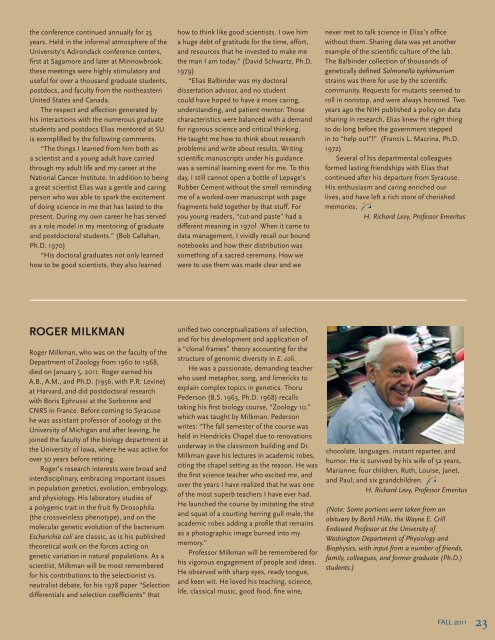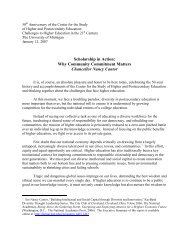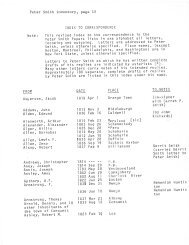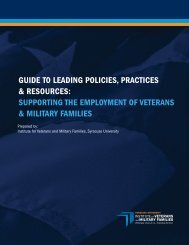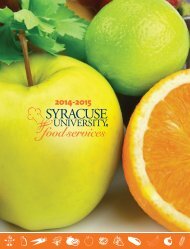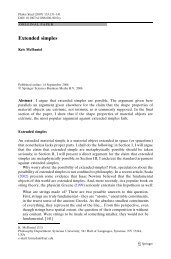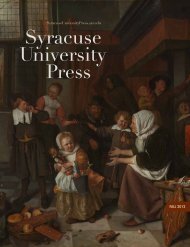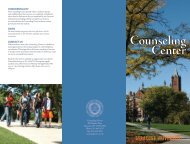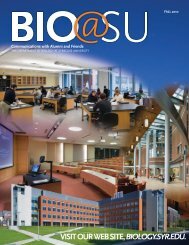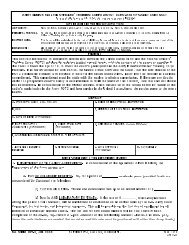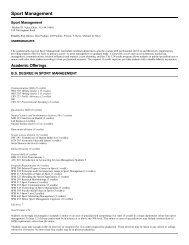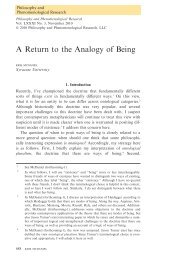Fall 2011 - the Department of Biology - Syracuse University
Fall 2011 - the Department of Biology - Syracuse University
Fall 2011 - the Department of Biology - Syracuse University
- No tags were found...
Create successful ePaper yourself
Turn your PDF publications into a flip-book with our unique Google optimized e-Paper software.
<strong>the</strong> conference continued annually for 25years. Held in <strong>the</strong> informal atmosphere <strong>of</strong> <strong>the</strong><strong>University</strong>’s Adirondack conference centers,first at Sagamore and later at Minnowbrook,<strong>the</strong>se meetings were highly stimulatory anduseful for over a thousand graduate students,postdocs, and faculty from <strong>the</strong> nor<strong>the</strong>asternUnited States and Canada.The respect and affection generated byhis interactions with <strong>the</strong> numerous graduatestudents and postdocs Elias mentored at SUis exemplified by <strong>the</strong> following comments.“The things I learned from him both asa scientist and a young adult have carriedthrough my adult life and my career at <strong>the</strong>National Cancer Institute. In addition to beinga great scientist Elias was a gentle and caringperson who was able to spark <strong>the</strong> excitement<strong>of</strong> doing science in me that has lasted to <strong>the</strong>present. During my own career he has servedas a role model in my mentoring <strong>of</strong> graduateand postdoctoral students.” (Bob Callahan,Ph.D. 1970)“His doctoral graduates not only learnedhow to be good scientists, <strong>the</strong>y also learnedhow to think like good scientists. I owe hima huge debt <strong>of</strong> gratitude for <strong>the</strong> time, effort,and resources that he invested to make me<strong>the</strong> man I am today.” (David Schwartz, Ph.D.1979)“Elias Balbinder was my doctoraldissertation advisor, and no studentcould have hoped to have a more caring,understanding, and patient mentor. Thosecharacteristics were balanced with a demandfor rigorous science and critical thinking.He taught me how to think about researchproblems and write about results. Writingscientific manuscripts under his guidancewas a seminal learning event for me. To thisday, I still cannot open a bottle <strong>of</strong> Lepage’sRubber Cement without <strong>the</strong> smell remindingme <strong>of</strong> a worked-over manuscript with pagefragments held toge<strong>the</strong>r by that stuff. Foryou young readers, “cut-and paste” had adifferent meaning in 1970! When it came todata management, I vividly recall our boundnotebooks and how <strong>the</strong>ir distribution wassomething <strong>of</strong> a sacred ceremony. How wewere to use <strong>the</strong>m was made clear and wenever met to talk science in Elias’s <strong>of</strong>ficewithout <strong>the</strong>m. Sharing data was yet ano<strong>the</strong>rexample <strong>of</strong> <strong>the</strong> scientific culture <strong>of</strong> <strong>the</strong> lab.The Balbinder collection <strong>of</strong> thousands <strong>of</strong>genetically defined Salmonella typhimuriumstrains was <strong>the</strong>re for use by <strong>the</strong> scientificcommunity. Requests for mutants seemed toroll in nonstop, and were always honored. Twoyears ago <strong>the</strong> NIH published a policy on datasharing in research. Elias knew <strong>the</strong> right thingto do long before <strong>the</strong> government steppedin to “help out”!” (Francis L. Macrina, Ph.D.1972)Several <strong>of</strong> his departmental colleaguesformed lasting friendships with Elias thatcontinued after his departure from <strong>Syracuse</strong>.His enthusiasm and caring enriched ourlives, and have left a rich store <strong>of</strong> cherishedmemories.H. Richard Levy, Pr<strong>of</strong>essor EmeritusROGER MILKMANRoger Milkman, who was on <strong>the</strong> faculty <strong>of</strong> <strong>the</strong><strong>Department</strong> <strong>of</strong> Zoology from 1960 to 1968,died on January 5, <strong>2011</strong>. Roger earned hisA.B., A.M., and Ph.D. (1956, with P.R. Levine)at Harvard, and did postdoctoral researchwith Boris Ephrussi at <strong>the</strong> Sorbonne andCNRS in France. Before coming to <strong>Syracuse</strong>he was assistant pr<strong>of</strong>essor <strong>of</strong> zoology at <strong>the</strong><strong>University</strong> <strong>of</strong> Michigan and after leaving, hejoined <strong>the</strong> faculty <strong>of</strong> <strong>the</strong> biology department at<strong>the</strong> <strong>University</strong> <strong>of</strong> Iowa, where he was active forover 30 years before retiring.Roger’s research interests were broad andinterdisciplinary, embracing important issuesin population genetics, evolution, embryology,and physiology. His laboratory studies <strong>of</strong>a polygenic trait in <strong>the</strong> fruit fly Drosophila(<strong>the</strong> crossveinless phenotype), and on <strong>the</strong>molecular genetic evolution <strong>of</strong> <strong>the</strong> bacteriumEscherichia coli are classic, as is his published<strong>the</strong>oretical work on <strong>the</strong> forces acting ongenetic variation in natural populations. As ascientist, Milkman will be most rememberedfor his contributions to <strong>the</strong> selectionist vs.neutralist debate, for his 1978 paper “Selectiondifferentials and selection coefficients” thatunified two conceptualizations <strong>of</strong> selection,and for his development and application <strong>of</strong>a “clonal frames” <strong>the</strong>ory accounting for <strong>the</strong>structure <strong>of</strong> genomic diversity in E. coli.He was a passionate, demanding teacherwho used metaphor, song, and limericks toexplain complex topics in genetics. ThoruPederson (B.S. 1963, Ph.D. 1968) recallstaking his first biology course, “Zoology 10,”which was taught by Milkman. Pedersonwrites: “The fall semester <strong>of</strong> <strong>the</strong> course washeld in Hendricks Chapel due to renovationsunderway in <strong>the</strong> classroom building and Dr.Milkman gave his lectures in academic robes,citing <strong>the</strong> chapel setting as <strong>the</strong> reason. He was<strong>the</strong> first science teacher who excited me, andover <strong>the</strong> years I have realized that he was one<strong>of</strong> <strong>the</strong> most superb teachers I have ever had.He launched <strong>the</strong> course by imitating <strong>the</strong> strutand squat <strong>of</strong> a courting herring gull male, <strong>the</strong>academic robes adding a pr<strong>of</strong>ile that remainsas a photographic image burned into mymemory.”Pr<strong>of</strong>essor Milkman will be remembered forhis vigorous engagement <strong>of</strong> people and ideas.He observed with sharp eyes, ready tongue,and keen wit. He loved his teaching, science,life, classical music, good food, fine wine,chocolate, languages, instant repartee, andhumor. He is survived by his wife <strong>of</strong> 52 years,Marianne; four children, Ruth, Louise, Janet,and Paul; and six grandchildren.H. Richard Levy, Pr<strong>of</strong>essor Emeritus(Note: Some portions were taken from anobituary by Bertil Hille, <strong>the</strong> Wayne E. CrillEndowed Pr<strong>of</strong>essor at <strong>the</strong> <strong>University</strong> <strong>of</strong>Washington <strong>Department</strong> <strong>of</strong> Physiology andBiophysics, with input from a number <strong>of</strong> friends,family, colleagues, and former graduate (Ph.D.)students.)FALL <strong>2011</strong>23


